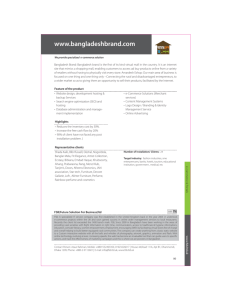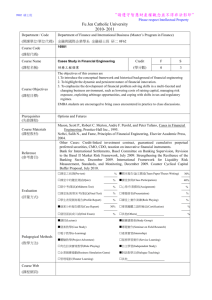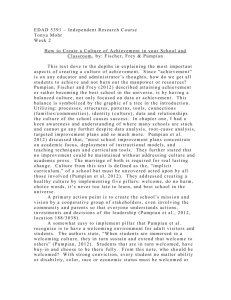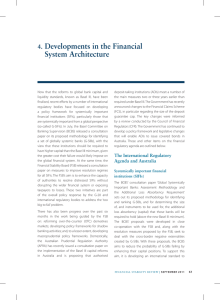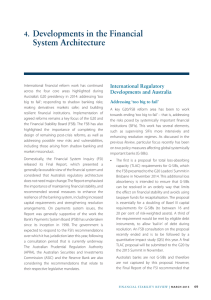Section 3 – Medium-term risks to financial stability
advertisement
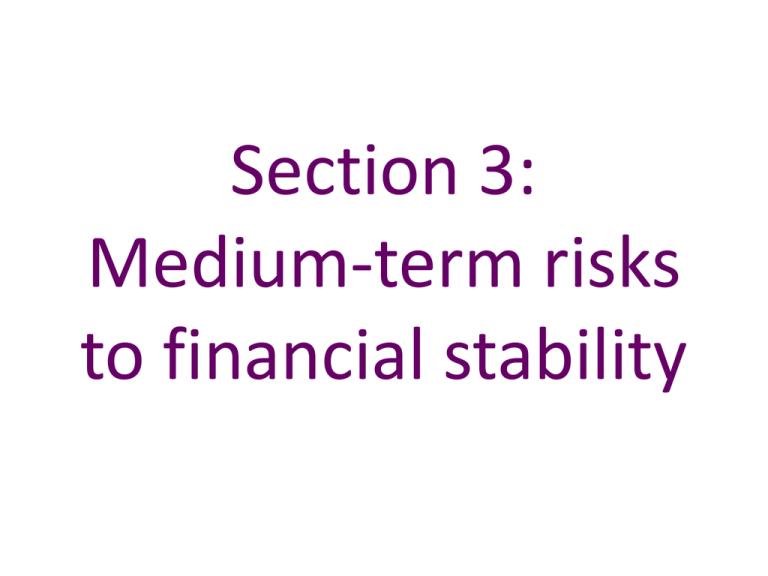
Section 3: Medium-term risks to financial stability Table 3.A Medium-term policy priorities Table 3.B Basel III increases the share of high-quality capital within the 8% total risk-weighted capital requirement(a)(b)(c) Sources: BCBS and BIS. (a) The table shows the requirements at full implementation of Basel III, which is envisaged in January 2019. (b) The table only includes capital requirements that apply to all banks (Pillar 1) and not the firm-specific (Pillar 2A) requirement. (c) ‘Going concern’ loss-absorbing capacity refers to a bank’s capacity to absorb losses without becoming insolvent. ‘Gone concern’ loss-absorbing instruments included in Tier 2 capital are those that can absorb losses once a bank’s Tier 1 capital is depleted (eg through debt restructuring and haircuts). Chart 3.1 Banks will be required to fund themselves with more ‘highquality’ capital over time Basel III Pillar 1 risk-weighted capital requirement(a)(b)(c) Sources: BCBS, BIS and Bank calculations. (a) CRD IV allows countries to set the minimum CET1 ratio in the range of 4%–4.5% (Basel III: 4%) and the minimum Tier 1 ratio in the range of 5.5%–6% (Basel III: 5.5%) in 2014. (b) Capital conservation buffer consists of CET1 capital. (c) There is no explicit Basel II standard mandating a 2% minimum CET1 requirement, but it is generally understood that CET1 should form the predominant part of Tier 1 capital. Table 3.C FPC and PRA can impose additional capital requirements and buffers Capital requirements under full implementation of Basel III in 2019(a)(b) Sources: BCBS, BIS, HM Treasury, ICB and PRA. (a) Under CRD IV, capital buffers are expected to consist of common equity (CET1). (b) G-SIBs are global systemically important banks as identified by the FSB. The equity buffer for ring-fenced banks will be the higher of the G-SIB buffer and the ring-fence buffer (to be introduced through the CRD IV ‘systemic risk buffer’). Domestic systemically important banks are yet to be identified and the level of capital surcharge is yet to be decided. (c) Macroprudential capital buffers consist of countercyclical capital buffer and sectoral capital requirements. (d) The total capital requirements for a firm may be greater than the numbers in (3) if a firm-specific capital requirement (Pillar 2A), macroprudential capital buffers or additional firm-specific capital buffer (Pillar 2B) are applied. Table 3.D Pillar 1 and Pillar 2 capital requirements try to deal with different sources of risks(a) Source: Bank of England. (a) The table covers the Pillar 2A capital requirement, and not the Pillar 2B capital buffer. Table 3.E A range of measures may be required to tackle the ‘too big to fail’ problem Examples of ex-ante and ex-post policy measures Source: Bank of England. Chart 3.2 Global systemically important banks are required to fund themselves with additional capital G-SIBs capital surcharge transition path by ‘bucket’ classifying banks by systemic importance(a)(b) Sources: BIS, CRR, FSB and Bank calculations. (a) Firms in bucket 4 are considered to be the most systemic of the G-SIBs. The FSB’s November 2013 G-SIB list includes HSBC (bucket 4), Barclays (bucket 3), Royal Bank of Scotland (bucket 2) and Standard Chartered (bucket 1). (b) Surcharge increases take effect as of 1 January of each year. Chart 3.3 CCPs risk insolvency without a mechanism to allocate exceptional losses A typical CCP default waterfall in the absence of a loss-allocation rule Source: Bank of England. Chart 3.4 Non-bank financial intermediaries’ assets continue to increase in dollar terms Covering 20 FSB member jurisdictions and euro area(a) Source: FSB. (a) Twenty jurisdictions and euro area. Table 3.F The FSB proposed a minimum haircut for certain types of securities-against-cash transactions(a) Source: FSB. (a) Numerical haircut floors for securities-against-cash transactions proposed by the FSB are aimed at non-centrally cleared transactions involving entities not subject to regulation of capital and liquidity/maturity transformation using non-government collateral. Chart 3.5 The proposed haircut would apply to a relatively small subset of the transactions Transactions subject to proposed floors, as of 2012 Source: FSB. Chart 3.6 Global securitisation markets are yet to recover European and US securitisation issuance(a)(b) Sources: Association for Financial Markets in Europe, Securities Industry and Financial Markets Association statistics and Bank calculations. (a) (b) (c) (d) (e) (f) (g) (h) US data updated to end-October 2013 and European (including Turkey, Kazakhstan, the Russian Federation and Iceland) data to end-September 2013. European data includes retained securitisation. Collateralised debt obligation. Asset-backed securities. Collateralised mortgage obligation. Mortgage-backed securities. Asset-backed securities, small and medium-sized enterprises and whole business securitisation. Residential mortgage-backed securities, commercial mortgage-backed securities and mixed mortgage-backed securities.


